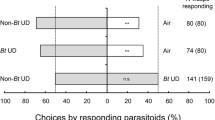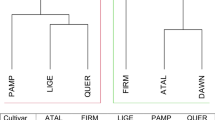Abstract
A wild rice,Oryza brachyantha, was rated as highly resistant to rice leaffolder,Cnaphalocrocis medinalis (Guenée), while its F1 hybrid from a cross with a high-yielding, leaffolder-susceptible rice, IR31917-45-3-2, was rated resistant in a standard screening test. In comparison with IR31917-45-3-2,O. brachyantha and the F1 hybrid were unsuitable for oviposition, survival, and growth ofC. medinalis. However, growth and survival of larvae in artificial diets containing lyophilized leaf powder of IR31917-45-3-2 andO. brachyantha were comparable. Studies on the feeding and settling preference of the larval stages suggested that the mechanism of resistance ofO. brachyantha is that of antixenosis type. Olfactometer tests with first-instar larvae and electroantennogram responses of adults indicated a lack or low levels of volatile attractants inO. brachyantha and the F1 hybrid in comparison with IR31917-45-3-2. Bioassays of sequential solvent extracts of these plants indicated that larval preference for IR31917-45-3-2 and nonpreference forO. brachyantha and the F1 hybrid were due partly to chemical factors present in hexane and methylene chloride extractables. Closer arrangement of silica cells in the epidermal layer ofO. brachyantha and a higher mandibular wear in larvae reared onO. brachyantha suggested that physical resistance due to silica may be an additional cause of resistance. It was hypothesized that the high levels of resistance observed inO. brachyantha may be due to an additive or synergistic action of the absence of attractants or feeding stimulants, the presence of deterrents, and the physical resistance offered by silica. The significance of these results to a successful wide hybridization program aimed at transferring resistance factors from wild rice to cultivated rice is discussed.
Similar content being viewed by others
References
Bernays, E.A., andChamberlain, D.J. 1982. The significance of dietary tannin for locusts and grasshoppers.J. Nat. Hist. 16:261–266.
Boiteau, G., andSingh, R.P. 1988. Resistance to the Greenhouse whitefly,Trialeurodes vaporarium (Westwood) (Homoptera: Aleyrodidae), in a clone of the wild potatoSolanum berthaultii Hawkes.Ann. Entomol. Soc. Am. 81:428–431.
Brar, D.A. andKhush, G.S. 1986. Wide hybridization and chromosome manipulation in cereals.In D.A. Evans, W.R. Sharp, and P.V. Ammirato (eds.). Handbook of Plant Cell Culture. Macmillan, New York. 221–263.
Cardona, C., Carnem, E.P. Kornegay, J., Valor, J., andSerrano, M. 1989. Antibiosis effects of wild dry bean accessions on the Mexican bean weevil and the bean weevil (Coleoptera: Bruchidae).J. Econ. Entomol. 82:310–315.
Coley, P.D. 1983. Herbivory and defensive characteristics of tree species in a lowland tropical forest.Ecol. Monogr. 53:209–233.
Davis, F.M., Ng Sen-Seong, andWilliams, W.P. 1989. Mechanisms of resistance in corn to leaf feeding by Southwestern corn borer and European corn borer (Lepidoptera: Pyralidae).J. Econ. Entomol. 82:919–922.
Duncan, D.B. 1951. A significant test for differences between ranked treatments in an analysis of variance.Va. J. Sci. 2:171–189.
Feeny, P.P. 1970. Seasonal changes in oak leaf tannins and nutrients as a cause of spring feeding by winter moth caterpillars.Ecology 51:565–581.
Guerin, P.M., andVisser, J.H. 1980. Electroantennogram responses of the carrot fly,Psila rosae to volatile plant components.Physiol. Entomol. 5:111–119.
Hamilton-Kemp, T.R., Andersen, R.A., Rodrigues, J.G., Loughrin, J.H., andPatterson, C.G., 1988. Strawberry foliage headspace vapor components at periods of susceptibility and resistance toTetranychus urticae Koch.J. Chem. Ecol. 14:789–796.
Hanifa, A.M., Subramianiam, T.R., andPonnaiya, B.W.X. 1974. Role of silicon in resistance to the leaf roller,Cnaphalocrocis medinalis Guenée in rice.Indian J. Exp. Biol. 12:463–465.
Heinrichs, E. A., Camanag, E., andA. Romena. 1985a. Evaluation of rice cultivars for resistance toCnaphalocrocis medinalis Guenée (Lepidoptera: Pyralidae).J. Econ. Entomol. 78:274–278.
Heinrichs, E.A., Viajante, V.D., andA. Romena. 1985b. Resistance of wild rices,Oryza spp. to the whorl maggotHydrellia philippina Ferino (Diptera: Ephydridae).Environ. Entomol. 14:404–407.
Heusing, J., andJones, D. 1988. Antibiosis to the tobacco hornworm (Manduca sexta) in wild species ofNicotiana.Entomol. Exp. Appl. 47:267–274.
IRRI (International Rice Research Institute). 1988. Standard evaluation system for rice. The International Rice Testing Programme, P.O. Box 933, Manila, Philippines.
Jena, K.K., andKhush, G.S. 1984. Embryo rescue of interspecific hybids and its scope in rice improvement.Int. Rice Genet. Newsl. 1:133–134.
Kauffman, W.C., andKennedy, G.G. 1989. Toxicity of allelochemicals from wild insect-resistant tomatoLycopersicon hirsutum f.glabratum toCampoletis sonorensis, a parasitoid ofHeliothis zea.J. Chem. Ecol. 7:2051–2060.
Khan, Z.R. 1987. Artificial diet for rearing rice leaffolder (LF).Int. Rice Res. Newsl. 12(6): 30–31.
Khan, Z.R., andSaxena, R.C. 1985. Behavioral and physiological responses ofSogatella furcifera (Homoptera: Delphacidae) to selected resistant and susceptible rice cultivars.J. Econ. Entomol. 78:1280–1286.
Khan, Z.R., Ciepiela, A., andNorris, D.M. 1987. Behavioral and physiological response of cabbage looper,Trichoplusia ni (Hubner) to steam distillates from resistant versus susceptible soybean plants.J. Chem. Ecol. 13:1903–1915.
Khan, Z.R., Barrion, A.T., Litsinger, J.A., Castilla, N.P., andJoshi, R.C. 1988. A bibliography of rice leaffolders (Lepidoptera: Pyralidae).Insect Sci. Appl. 9:129–174.
Khan, Z.R., Rueda, B.P., andCaballero, P. 1989. Behavioral and physiological responses of rice leaffolder,Cnaphalocrocis medinalis to selected wild rices.Entomol Exp. Appl. 52:7–13.
Lin, S.Y.H., Trumble, J.T., andKumamoto, J. 1987. Activity of volatile compounds in glandular trichomes ofLycopersicon species against two insect herbivores.J. Chem. Ecol. 7:707–716.
Litsinger, J.A., Barrion, A.T., andSoekarna, D. 1987. Upland rice insect pests: Their ecology, importance, and control. IRRI Research Paper Series No. 123. International Rice Research Institute, Los Banos, Laguna, Philippines.
Liu, S.H., Norris, D.M., andMarti, E. 1988. Behavioral responses of female adultTrichoplusia ni to volatiles from soybeans versus a preferred host, lima bean.Entomol. Exp. Appl. 49:99–109.
Medina, E.B., andTyron, E.H. 1986. Resistance of selectedOryza sativa andO. brachyantha cultivars to the rice leaffolder.Int. Rice Res. Newsl. 11(6): 10–11.
Mohandas, N. 1975. Studies on the chemical control and insect-plant relationship of the rice leafroller,Cnaphalocrocis medinalis Guenée (Pyraustidae: Lepidoptera). PhD thesis. Kerala Agricultural University, Kerala, India.
Otieno, D.A., Hassanali, A., andNjoroge, P.W. 1985. Chemical basis of TVu 946 stem resistance toMaruca testulalis (Geyer).Insect. Sci. Appl. 6:259–262.
Painter, R.H., 1951. Insect Resistance in Crop Plants. Macmillan, New York.
Ramachandran, R., Khan, Z.R., Caballero, P., andJuliano, B.O. 1990. Olfactory sensitivity of two sympatric species of rice leaffolders (Pyralidae: Lepidoptera) to plant volatiles.J. Chem. Ecol. 16:2647–2666.
Raubenheimer, D., andSimpson, S.J. 1990. The effects of simultaneous variation in protein, digestible carbohydrate and tannic acid on the feeding behavior of larvalLocusta migratoria (L.) andSchistocerca gregaria (Forskal). I. Short-term studies.Physiol. Entomol. 15:219–233.
Raupp, M.J. 1985. Effects of leaf toughness on mandibular wear of leaf beetle,Plagiodera versicolora.Ecol. Entomol. 10:73–79.
Rembold, H., andTober, H. 1985. Kairomones as pigeonpea resistance factors againstHeliothis armigera.Insect Sci. Appl. 6:249–252.
Reynolds, G.W., Smith, C.M., andKester, K.M. 1985. Reductions in consumption, utilization, and growth rate of soybean looper (Lepidoptera: Noctuidae) larvae fed foliage of soybean genotype PI 227687.J. Econ. Entomol. 77:1371–1375.
Saxena, K.N. 1969. Patterns of insect plant relationships determining susceptibility or resistance of different plants to an insect.Entomol. Exp. Appl. 12:751–776.
Smith, C.M. 1985. Expression, mechanisms and chemistry of resistance in soybean,Glycine max L. (Merr.) to the soybean looper,Pseudoplusia includens (Walker).Insect Sci. Appl. 6:243–248.
Waldbauer, G.P., andMarciano, A.P. 1979. Mass rearing of the rice leaffolder,Cnaphalocrocis medinalis Guenée (Lepidoptera: Pyralidae) under greenhouse conditions.J. Entomol. Res. 3:1–8.
Webster, J.A. 1975. Association of plant hairs and insect resistance: an annotated bibliography. Agricultural Research Service Miscellaneous Publication 1297. United States Department of Agriculture, Washington, D.C.
Wilson, R.L., Wiseman, B.R., andWidstrom, N.W. 1984. Growth response of corn earworm (Lepidoptera: Noctudeae) larvae on meridic diets containing fresh and lyophilized corn silk.J. Econ. Entomol. 77:1159–1162.
Wiseman, B.R. 1985. Types and mechanism of host plant resistance to insect attack.Insect Sci. Appl. 6:239–242.
Wiseman, B.R., Davis, F.M., andWilliams, W.P. 1983. Fall armyworn: Larval density and movement as an indication of nonpreference in resistant corn line.Prot. Ecol. 5:135–141.
Yoshida, S., Forno, D.A., Cock, J.H., andComez, K.A. 1976. Laboratory manual for physiological studies of rice. Third edition. The International Rice Research Institute, Los Banos, Laguna, Philippines.
Zar, J.H. 1984. Biostatistical Analysis. Prentice-Hall, Englewood Cliffs, New Jersey.
Author information
Authors and Affiliations
Rights and permissions
About this article
Cite this article
Ramachandran, R., Khan, Z.R. Mechanisms of resistance in wild riceOryza brachyantha to rice leaffolderCnaphalocrocis medinalis (Guenée) (Lepidoptera: Pyralidae). Journal of Chemical Ecology 17, 41–65 (1991). https://doi.org/10.1007/BF00994421
Received:
Accepted:
Issue Date:
DOI: https://doi.org/10.1007/BF00994421




